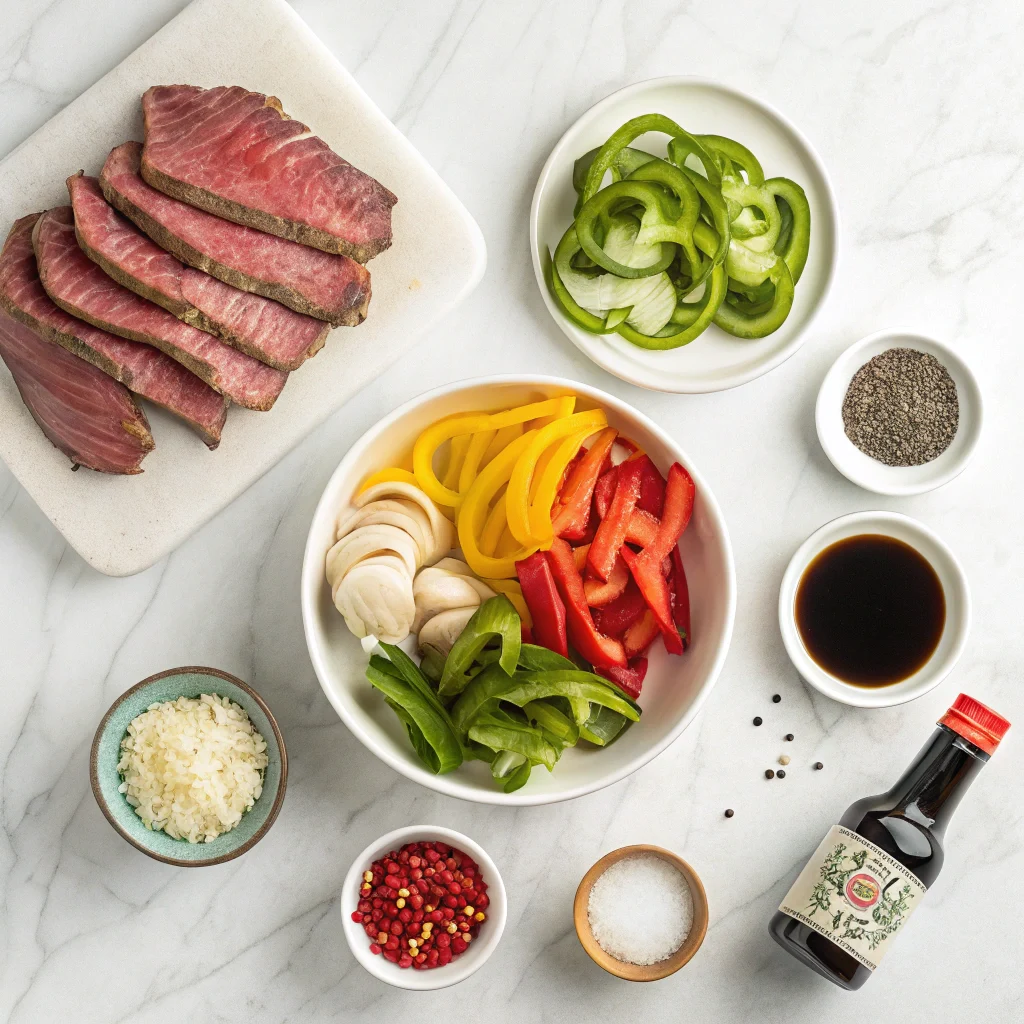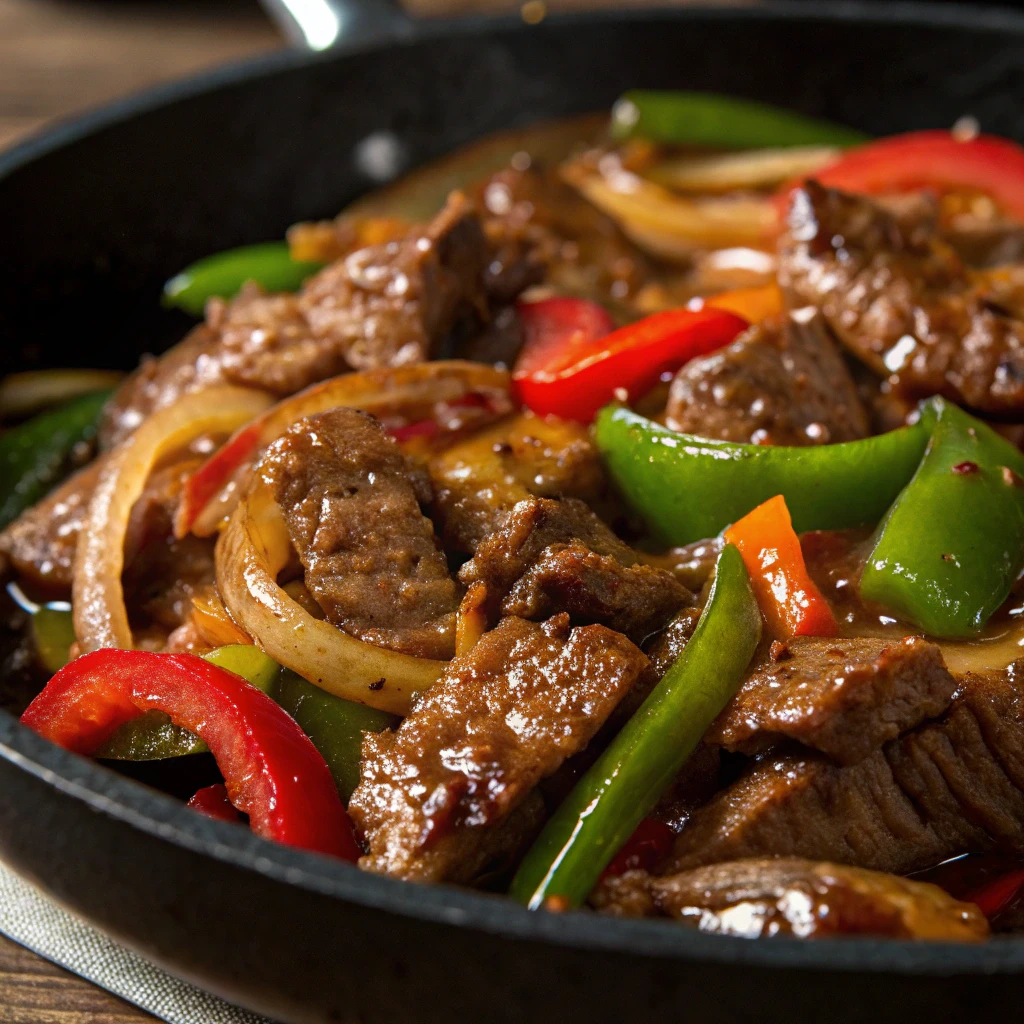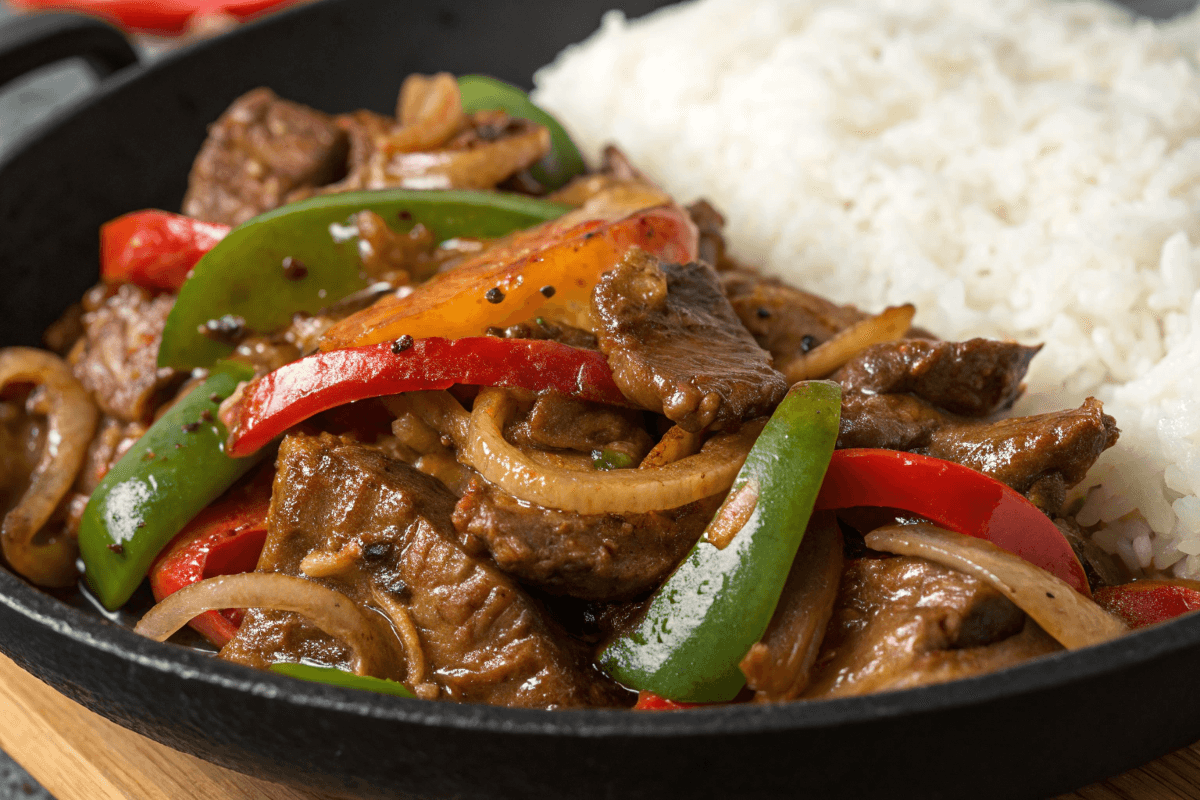If you’re craving a quick, delicious, and restaurant-quality meal at home, this pepper steak recipe is just what you need! A staple in Chinese-American cuisine, this dish features tender slices of beef stir-fried with crisp bell peppers and onions, all coated in a rich, savory sauce. Best of all? It’s surprisingly easy to make with just a few simple ingredients.
In this guide, we’ll cover everything you need to know to make the best pepper steak right in your kitchen. From choosing the perfect cut of beef to mastering the stir-fry technique, this article will walk you through the process step by step. We’ll also explore tasty variations, serving ideas, and storage tips to ensure you enjoy this dish to the fullest.
Why Pepper Steak Feels Like Home to Me
Pepper steak has always been one of my comfort dishes. I still remember the rich aroma filling the kitchen when I first learned to cook it. The tender beef, colorful peppers, and savory sauce always make me feel at home. It’s simple, flavorful, and always brings a smile to my face. ♥
Introduction to Pepper Steak
What is Pepper Steak? A Classic Stir-Fry Dish
Pepper steak is a flavorful stir-fry made with thinly sliced beef, bell peppers, and onions, all tossed in a savory sauce. This dish is known for its bold flavors, tender meat, and colorful vegetables, making it a visually appealing and satisfying meal.
While often associated with Chinese-American cuisine, similar versions of pepper steak exist worldwide. Some variations use different cuts of meat, spice levels, or extra veggies to customize the dish to personal tastes.
The History of Pepper Steak in Chinese-American Cuisine
The origins of pepper steak can be traced back to Chinese immigrants who brought stir-fry techniques to the United States. Traditional Chinese stir-fry dishes often feature sliced meat cooked quickly over high heat, but pepper steak was adapted to suit American palates by adding a thick, flavorful sauce.
Over time, this dish became a staple in Chinese takeout menus across the country. The balance of umami-rich soy sauce, sweet bell peppers, and tender beef makes it a crowd-pleaser, loved by home cooks and restaurant diners alike.
Why This Dish is a Family Favorite
There’s a reason pepper steak is a go-to dish for busy families. Here’s why:
- Quick and Easy: You can have this dish ready in under 30 minutes.
- Budget-Friendly: Uses affordable cuts of beef and simple pantry staples.
- Versatile: Can be served over rice, noodles, or even low-carb alternatives like cauliflower rice.
- Make-Ahead Friendly: Leftovers taste just as good the next day!
With its bold flavors, ease of preparation, and versatility, it’s no surprise that pepper steak remains a beloved dish for many households.
Nutrition Breakdown
| Nutrient | Amount per Serving |
|---|---|
| Calories | 365 kcal |
| Protein | 32g |
| Total Fat | 4g |
| Saturated Fat | 1g |
| Carbohydrates | 48g |
| Fiber | 4g |
| Sugar | 5g |
| Sodium | 465mg |
Ingredients for the Perfect Pepper Steak
A great pepper steak recipe starts with the right ingredients. Choosing high-quality meat, fresh vegetables, and flavorful seasonings ensures that your dish turns out tender, juicy, and packed with bold flavors. Let’s break down the essential ingredients and some creative substitutions to fit different dietary needs.

Choosing the Right Cut of Beef for Tender Pepper Steak
Not all beef cuts are created equal when it comes to stir-frying. The key to achieving tender, melt-in-your-mouth beef is selecting the right cut and slicing it properly.
Here are the best beef options for a pepper steak recipe:
- Top Round: A lean, budget-friendly cut that becomes tender when sliced thinly and cooked quickly.
- Flank Steak: Slightly more expensive but perfect for stir-fries due to its deep beefy flavor and great texture.
- Sirloin: A versatile and widely available option that balances tenderness and flavor.
- Ribeye (for indulgence): If you want extra juiciness and marbling, ribeye is a premium choice.
✓Pro Tip: Always slice the beef against the grain into thin strips. This shortens the muscle fibers, making the meat tender rather than chewy.
Essential Ingredients: Bell Peppers, Soy Sauce, and More
Besides beef, the other ingredients in a pepper steak recipe help create its signature taste. Here’s what you’ll need:
- Bell Peppers: Green, red, or yellow bell peppers add sweetness, crunch, and vibrant color.
- Onions: Sliced onions provide a mild sweetness that enhances the dish.
- Garlic & Ginger: These aromatics add depth and a slightly spicy kick.
- Soy Sauce: A key ingredient that delivers salty, umami richness.
- Beef Broth: Used to create a flavorful sauce base and keep the beef juicy.
- Cornstarch: Helps thicken the sauce and gives the beef a silky coating.
- Paprika: A hint of smokiness to enhance the dish’s overall flavor.
Substitutions and Variations for Special Diets
Want to adjust your pepper steak recipe to meet specific dietary needs? Here are some simple swaps:
- Gluten-Free: Use tamari or coconut aminos instead of soy sauce.
- Low-Carb/Keto: Skip the cornstarch and use xanthan gum as a thickener.
- Vegetarian/Vegan: Replace beef with mushrooms, tofu, or jackfruit.
- Extra Spicy: Add crushed red pepper flakes, chili oil, or Sriracha.
Now that you have all the ingredients ready, let’s move on to making the perfect pepper steak recipe!
Step-by-Step Guide to Making Pepper Steak
Now that we’ve gathered our ingredients, it’s time to cook! This simple yet flavorful stir-fry comes together in just a few easy steps.
Step 1: Preparing the Meat – Slicing and Marinating for Maximum Flavor
The first step in creating a delicious pepper steak recipe is prepping the beef:
- Slice the meat thinly against the grain. Aim for strips about ¼-inch thick.
- In a bowl, mix soy sauce, cornstarch, and a splash of beef broth to make a quick marinade.
- Add the sliced beef and let it marinate for at least 15–20 minutes (or up to an hour for deeper flavor).
✓Why marinate? The cornstarch forms a thin protective layer on the beef, keeping it juicy and tender during cooking.
Step 2: Stir-Frying Techniques – Achieving the Perfect Sear
A good stir-fry is all about heat and speed. Follow these steps to get that restaurant-quality sear:
- Heat a tablespoon of oil in a large skillet or wok over medium-high heat.
- Once hot, add the marinated beef in a single layer. Let it cook for 1–2 minutes without stirring to develop a nice sear.
- Stir-fry for another 1–2 minutes until browned, then remove the beef and set it aside.
✓Pro Tip: Don’t overcrowd the pan! Cook the beef in batches if needed to avoid steaming.
Step 3: Creating the Savory Sauce – Balancing Flavors and Thickness
The sauce is what makes this pepper steak recipe shine. Here’s how to make it perfect:
- In the same pan, add a bit more oil and sauté the onions, bell peppers, garlic, and ginger for 2–3 minutes.
- In a small bowl, whisk together:
- ½ cup beef broth
- 2 tablespoons soy sauce
- 1 tablespoon cornstarch (to thicken)
- ½ teaspoon paprika (for extra flavor)
- Pour the sauce over the veggies and stir well to combine.
Step 4: Final Assembly – Bringing the Dish Together
Now it’s time to finish the dish:
- Add the cooked beef back into the pan, stirring to coat everything in the sauce.
- Let everything simmer for 2–3 minutes, allowing the sauce to thicken and absorb into the meat.
- Taste and adjust seasoning if needed – add more soy sauce for saltiness or a touch of sugar for balance.
Serve your delicious pepper steak recipe over hot, steamed rice or noodles, and enjoy!

Pepper Steak Variations
One of the best things about a pepper steak recipe is its versatility. Whether you love a spicy kick, prefer a healthier version, or want to switch up the flavors, there are plenty of ways to customize this dish. Here are some delicious variations to try.
Spicy Pepper Steak – Adding Heat with Chili Peppers
For those who love a bit of spice, adding chili peppers or hot sauce can transform this dish into a fiery delight. Try:
- Fresh chilies: Thinly sliced Thai chilies or jalapeños for a bold, fresh heat.
- Red pepper flakes: A pinch adds an easy spice boost.
- Sriracha or hot sauce: Mix it into the sauce for a tangy, spicy flavor.
- Black pepper overload: Double up on black pepper for a bold, peppery kick.
✓Pro Tip: Start with a small amount of spice and adjust based on your heat tolerance!
Garlic and Ginger Pepper Steak – Boosting Aromatics
For an extra depth of flavor, enhance your pepper steak recipe with:
- More garlic: Instead of two cloves, use four or five for a richer taste.
- Freshly grated ginger: Adds a mild spiciness and a touch of sweetness.
- Sesame oil: A drizzle at the end boosts the dish’s nutty aroma.
This version is perfect for those who love Asian-inspired flavors!
Vegetarian and Vegan Alternatives – Using Tofu or Mushrooms
Want to skip the beef? No problem! Try these tasty swaps:
- Firm tofu: Cut into cubes and pan-fried until golden brown.
- Mushrooms: Portobello, cremini, or shiitake mushrooms mimic the meaty texture.
- Jackfruit: A fantastic substitute that shreds like beef when cooked.
Use soy sauce, veggie broth, and cornstarch for the sauce to keep the dish plant-based.
Sauce Variations – Oyster Sauce, Hoisin, and More
Want to switch up the sauce? Try these flavorful options:
- Oyster sauce: Adds a deep umami richness.
- Hoisin sauce: Gives a hint of sweetness and depth.
- Honey or brown sugar: Balances out the savory elements.
- Coconut aminos: A gluten-free, soy-free alternative with a naturally sweet taste.
These variations allow you to tailor your pepper steak recipe to match your taste preferences.
What to Serve with Pepper Steak
A delicious pepper steak recipe is fantastic on its own, but pairing it with the right side dishes takes it to the next level. Here are some great options to complete your meal.
The Best Rice to Pair with Pepper Steak
Rice is the go-to base for pepper steak, soaking up the rich sauce and adding a satisfying texture. Here are some top choices:
- Jasmine rice: Light and fluffy with a slightly floral aroma.
- Basmati rice: Long-grain rice with a nutty flavor.
- Brown rice: A healthier option with a chewy texture.
✓ Pro Tip: Cook your rice with a splash of chicken broth for extra flavor.
Low-Carb Alternatives – Cauliflower Rice or Zoodles
Looking for a lighter option? Swap out traditional rice for:
- Cauliflower rice: Low in carbs but still great for soaking up sauce.
- Zoodles (zucchini noodles): Adds a fresh, slightly crunchy texture.
- Shirataki noodles: A zero-calorie alternative that pairs well with the sauce.
These options keep the dish light without sacrificing flavor!
Side Dish Ideas – Roasted Vegetables, Stir-Fried Greens, or Spring Rolls
Balance your meal with some tasty sides:
- Roasted asparagus: Toss with olive oil, salt, and pepper for a simple, tasty side.
- Stir-fried bok choy: Adds freshness and a slight crunch.
- Spring rolls: Crispy, light, and perfect with a dipping sauce.
- Egg drop soup: A comforting, light appetizer that pairs well with pepper steak.
With so many pairing options, you can create a well-rounded and satisfying meal!
How to Store and Reheat Pepper Steak
One of the best things about a pepper steak recipe is that it makes excellent leftovers. Whether you want to enjoy it the next day or freeze it for later, storing it properly ensures you maintain its flavor and texture.
Refrigeration Tips – Keeping Leftovers Fresh
If you have leftover pepper steak, follow these steps to keep it fresh:
- Cool it down: Let the dish cool to room temperature before storing it.
- Use an airtight container: Store the beef and sauce in a sealed container to prevent it from drying out.
- Refrigerate promptly: Keep it in the fridge within two hours of cooking.
- Consume within four days: For the best taste, eat it within a few days.
✓ Pro Tip: Store the rice separately to prevent it from getting soggy.
Freezing Pepper Steak – Does It Hold Up?
Yes! A pepper steak recipe freezes well, but there are a few things to keep in mind:
- Use freezer-safe bags or containers to prevent freezer burn.
- Remove excess air before sealing the bag to keep the flavors locked in.
- Label with the date so you know when to use it (best within three months).
- Avoid freezing rice with the steak—rice tends to get mushy when thawed.
When you’re ready to eat it, let it thaw in the fridge overnight before reheating.
Best Reheating Methods – Stovetop vs. Microwave
To keep your pepper steak recipe tasting fresh, use these reheating methods:
- Stovetop: Heat a pan over medium heat, add a splash of beef broth or water, and stir until warmed through.
- Microwave: Place the steak in a microwave-safe dish, cover lightly, and heat in 30-second intervals, stirring in between.
✓ Avoid overheating! Too much heat can make the beef tough and dry.
Now that you know how to store and reheat pepper steak, let’s answer some common questions!
Frequently Asked Questions
Still have questions about making the perfect pepper steak recipe? Here are some of the most common ones!
How Do You Keep Pepper Steak from Becoming Tough?
Tough meat is a common issue, but it’s easy to avoid. Here’s how:
- Slice against the grain: This shortens the muscle fibers, making the beef tender.
- Use the right cut: Flank steak, sirloin, or top round are ideal for stir-frying.
- Don’t overcook: Cook the beef quickly over high heat to keep it juicy.
- Marinate properly: Letting the beef sit in a soy sauce-based marinade helps tenderize it.
Can You Use Chicken Instead of Beef?
Yes! You can swap beef for chicken, pork, or even shrimp to make a different version of pepper steak. Follow the same steps but:
- Use thinly sliced chicken breast for a leaner option.
- Cook pork tenderloin the same way as beef.
- If using shrimp, reduce the cooking time to just a few minutes.
What’s the Best Way to Thicken the Sauce?
A thick, glossy sauce is key to a great pepper steak recipe. Here’s how to achieve it:
- Cornstarch slurry: Mix 1 tablespoon cornstarch with 2 tablespoons water, then stir it into the sauce.
- Simmer longer: Let the sauce cook down slightly to reduce and thicken.
- Arrowroot powder: A great alternative to cornstarch for gluten-free cooking.
How Can I Make This Recipe Less Salty?
If your dish turns out too salty, try these fixes:
- Use low-sodium soy sauce or coconut aminos.
- Add more veggies like bell peppers, onions, or mushrooms to balance the saltiness.
- Dilute with water or beef broth to lighten the sauce.
✓ Pro Tip: Always taste as you cook to adjust flavors as needed!

